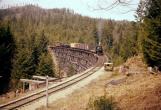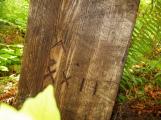1
Steam train crossing Trestle1950-1960
Kinsol Trestle, Cowichan Valley, Vancouver Island, BC Canada
 Credits:
Credits:Dave Wilkie Photographer
Western Canadian Railway Association Archives
2
From the time it was decommissioned in 1979, various organizations and individuals petitioned the provincial and federal governments for an official heritage designation for the Kinsol Trestle. Dozens of reports were prepared over the years that included an analysis of the historical significance of the trestle, which was part of Canada's expanding railway system. These include reports commissioned by the Cowichan and Chemainus Valleys Eco-Museum Society in 1989 (now defunct, the organization was dedicated to the preservation of heritage sites for their tourism potential) and by historian Robert W. Passfield in 1991 for the Historic Sites and Monuments Board of Canada.In 1982, the Province of British Columbia approved, in principle, the acquisition of the abandoned CN right-of-way and in 1984 acquired it. In March of that year, the Heritage Conservation Branch of the provincial government conducted a review of the trestle and made the following observation:
"...it has been recommended by the public and the press that the Trestle be designated a Heritage Site under Sec. 4 of the Heritage Conservation Act...In the public mind, this Ministry would be under a moral obligation to refurbish and maintain the structure."
In its conclusion, the report recommended that an alternative designation be placed on the trestle - a "Notification of Interest - Extended Term", which would be effective for five years. It is evident from this report that designating the trestle as a heritage site would result in the government assuming responsibility for its maintenance. Instead, with a "Notification of Interest", the Kinsol Trestle received no maintenance at all.
3
CNR locomotive 2104 crossing TrestleMarch 1956
Kinsol Trestle, Cowichan Valley, Vancouver Island, BC Canada
 Credits:
Credits:David Wilkie, Photographer
BC Railway Historical Association
4
Jack Fleetwood, the revered Cowichan Valley historian and journalist who passed away in 1998, sought to have the trestle declared a provincial heritage site in 1984. In a series of letters, he appealed directly to James R. Chabot in the Ministry of Provincial Secretary and Government Services. Jack was passionate about the tourism potential of the trestle and promoted the establishment of a park around it in his efforts to establish the site as a major tourism draw in the Cowichan Valley.To acquire funding for the rehabilitation of the Kinsol Trestle, a Statement of Significance (SOS) had to be prepared. In the case of a structure like the trestle, an SOS includes a description of a historic place, and a statement regarding its heritage value and its character-defining elements. This process is mandatory for any structure to be considered for inclusion in the Canadian Register of Historic Places and the BC Register of Historic Places.
An SOS workshop for the Kinsol Trestle took place at the Cowichan Valley Museum & Archives in November 2007 and was facilitated by Richard Linzey, then Senior Heritage Planner for the Heritage Branch of BC. The purpose of the meeting was to bring together a group of people who would help define the significance of the trestle. By eliciting values from the group, which consisted of historians, heritage specialists and others, a profile of heritage values and character-defining features was constructed. The community's values - the reasons why they thought the trestle was worthy of preservation - were discussed for the preparation of the SOS. After the workshop, and with consultation with history and heritage experts, the SOS was prepared by Commonwealth Heritage Resource Management. Several heritage values were identified through the process:
The trestle is significant as a symbol of nation building; it has historic value as part of an expanding railroad system across Canada that was essential to the economic development of Vancouver Island and British Columbia. The massive timber structure represents a bygone era and symbolizes an economy built on the distribution of natural resources.
The trestle's elegant, seven-degree curve, its dramatic placement in the landscape, its vertiginous height and the visual appeal of the weathered timbers speak to its aesthetic value.
Trestles are examples of early railway engineering and are unique monuments in the British Columbia landscape. The Kinsol Trestle has value as an example of our architectural heritage; it is the only historic timber-framed railway bridge of its size and type in the British Commonwealth. The techniques used to build it are an example of the ingenuity and skill required to overcome the challenges of a difficult terrain. Construction of the heavy timber framing speaks to the kind of men who built it - with horse and steam power and their own strength. Given the scope of their task - using the most available resource, wood - the trestle is an architectural marvel.
The character-defining elements of the trestle include the geometry and complexity of the structure, the patina of the Douglas fir timbers, the water barrel stands placed on the bridge for fire-fighting purposes, the unique numbering system chiseled into the timber, and the inspection ladders.
5
Detail of identification codeMay 2007
Kinsol Trestle, Cowichan Valley, Vancouver Island, BC Canada
 Credits:
Credits:Shawnigan Lake Historical Society
6
Early in the preservation efforts, there were proposals to completely dismantle the aging Kinsol Trestle and replace it with a poor imitation of the original. All new materials would be used on the replacement bridge which would have far fewer bents and retain none of the character-defining elements unique to the original. "Kinsol Lite" as it was referred to in the media, would have been unable to compete with the "real" thing.Gordon Macdonald, Managing Director, Macdonald & Lawrence Timber Framing Co. (M&L), based on Vancouver Island, BC, is internationally renowned for his conservation work on heritage timber structures. He is part of an international team sponsored by New Zealand's Antarctic Heritage Trust to conserve the wooden huts of Antarctic explorers Sir Ernest Shackleton and Robert Falcon Scott. M&L was also involved in the conservation of the timber roof of Windsor Castle after the devastating 1992 fire. Gordon undertook studies of the Kinsol Trestle initially on his own and then as part of the Commonwealth Heritage Resource Management team for the Cowichan Valley Regional District (CVRD). In his interview, he discussed the importance of retaining the original fabric and design of a heritage structure and the significance of doing this:
AUDIO: Gordon Macdonald
Think of any imperiled architectural treasure which is currently languishing and we hope might be conserved; they'll all have one thing in common, which is that they are prohibitively expensive and there's an enormous amount of inertia which has been built up over the years and a general perception that it's just not really realistic. Otherwise, it would have been done. If it were easy, people would have been doing it for years and years. All of those projects, and the Kinsol, again, is no exception; they need to turn the corner philosophically before they can turn the corner materially. And in this instance that meant, first of all, getting some traction behind the idea that it was safe and practical to do something as ambitious as fixing the Kinsol, and then secondly, that once conserved, people would use and enjoy it, and that that would bring all sorts of other benefits to the Valley, benefits that could only come from conserving the historic object and wouldn't be available if one crunched it up and burned it and replaced it with something that looks kind of like it. That would have a different result, and that other result could be really positive, and there's good evidence of that in the Kettle Valley, for example, where the bridges were destroyed and replaced with lookalike bridges, that don't exactly match the original structures, and people go to the Kettle Valley and enjoy riding along the trails, and that project has been a great success, not as a conservation project or a heritage project but it's successful as a tourist venture. This is different, and what is so special about the Kinsol is that it is the original and there are very few of these things left around. So we can take this extra pride in having saved something of real significance, or real heritage importance. There aren't many around and as a result of that people will come for that reason. But the other thing too is that people usually look at these great decrepit structures or buildings or whatever they are and they just generally feel funky and gloomy about them because that's the overall vibe that has developed over time. And they forget that there's a remarkable opportunity in fundraising around heritage that doesn't exist on clear construction sites. So everybody wants the Trans Canada Trail crossing to be established and everyone accepts that it will be quite expensive to do that. To start from scratch, to fundraise for a new bridge after having spent a million dollars to get rid of the old one, which was kind of annoyingly in the way, is a pretty formidable task. To fundraise around a conservation effort and around the saving of an imperiled structure is actually a lot easier because it's pretty easy to get people excited about the idea of saving something which is beautiful and old and at risk.
7
Gordon Macdonald considers importance of retaining aesthetic characteristics26 November 2010
Kinsol Trestle, Cowichan Valley, Vancouver Island, BC Canada
 Credits:
Credits:Gordon Macdonald, Speaker
Cowichan Valley Museum and Archives
8
Sign for Cowichan Valley Trail bypass2007
Kinsol Trestle, Cowichan Valley, Vancouver Island, BC Canada
 Credits:
Credits:Cowichan Valley Museum & Archives
9
Chief Glen Sanders, who was responsible for extinguishing two fires at the Trestle (1988 and 1998), drew a comparison between an historical landmark on the east coast and the Kinsol Trestle on the west coast:AUDIO: Glen Sanders
I had an opportunity to go visit the lighthouse at Peggy's Cove, and it's unique in its own way and it's, I suppose, world famous...you see it on postcards and everything else but that's a significant piece of....history for Canada on the east coast and we've got this (the Kinsol Trestle) here and this has been hidden away for so many years. There's so much history involved with this. This is a much bigger structure than the lighthouse at Peggy's Cove but the engineering and the, just the logistics of building a bridge of this magnitude way out in the bush. The way that they did that is just phenomenal. You go out now and you wonder, how did they ever build this way back when they did that without the, you know, use of helicopters and everything that we have today? So, it is a huge testament to the engineering and the, you know, work ethic of the people involved.
10
Glen Sanders on signficance of Trestle20 July 2010
Kinsol Trestle, Cowichan Valley, Vancouver Island, BC Canada
 Credits:
Credits:Glen Sanders, Speaker
Shawnigan Lake Historical Society